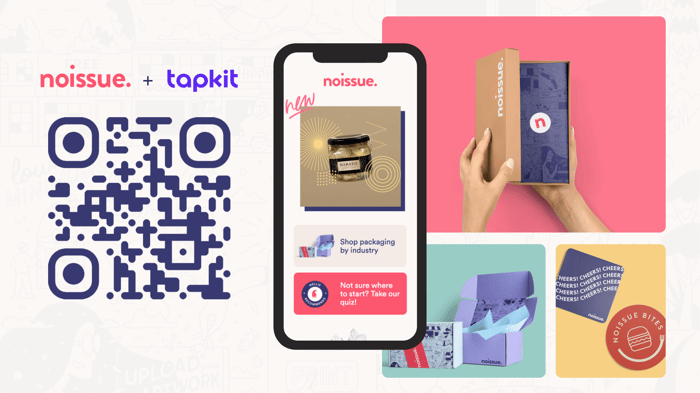
What is Tapkit? Here’s Everything You Need to Know About noissue’s Acquisition
We're excited to announce that noissue has acquired Tapkit, an all-in-one creative link tool to build microsites and dynamic QR codes. Here's how including a QR code on packaging can create a unique and engaging experience for your customers.
By Elly Strang — 06 April, 2022
We’ve got some exciting news to share here at noissue: we have acquired Tapkit, an all-in-one creative link tool to build microsites and dynamic QR codes! Tapkit has created digital experiences for high-profile brands such as L’Oreal, NYX, Haus, TRIBE, Little Cooks, and more. Tapkit’s team will be joining noissue’s global Product, Design and Engineering team to bring digital experiences to our packaging range through QR code technology.
What does this mean for noissue’s customers? From today, you will be able to easily integrate QR code technology into your custom packaging and bridge the gap between your brand’s physical and digital experiences.
noissue's custom packaging products are QR code compatible with Tapkit’s technology. QR codes (which can be printed as small as a 2cm square) can be added to our custom products like boxes, hang tags, cards, coasters, kraft mailers, and tape.
Displaying a dynamic QR code on your packaging gives you the opportunity to further engage, interact with and educate your customer at the moment of their unboxing.
If you’re not fully up to speed with everything that’s possible with a QR code yet, don’t worry – we’ve got you! Check out our in-depth guides below to learn more about designing packaging with QR codes, building microsites and the different use cases for QR codes:
• How to make your QR code print perfect for custom packaging
• What is a microsite? Here’s how your brand can engage customers through QR campaigns
• 17 creative ways to use a QR code for any business.
What is a QR code?
QR stands for a “quick response” code. Simply put, it’s a barcode that can be scanned by a digital device and sends the recipient to a landing page (AKA a microsite).
This makes it a creative solution for sharing relevant content and experiences with your customers. Brands across the world are using QR codes to provide a way for customers to quickly reorder products, showcase a new product or fashion collection, share their founder’s story and much more.
“From “makeup how-to guides” or “cooking instructional videos” to collecting feedback, enabling quick re-orders and running UGC competitions, the opportunities to create and integrate digital experiences that enhance a consumer’s physical experience with a brand and product are endless, and we’re proud to be merging packaging and technology to power this future,” Tapkit’s founder and CEO Matt Alcock says.
Once your packaging featuring a QR code has been delivered, you can also unlock further insights about your customers through Tapkit with reports of how many scans and views the code has had, data on audience locations in real-time, and more.
What is a microsite?
A microsite is a mobile-first website, which makes it the ideal destination to send customers to after they scan a QR code on your packaging.
These miniature websites are endlessly customizable, which means they can be updated to show your latest products, helpful articles, and other interactive parts of your brand.
Learn more about how your brand can engage customers through microsite and QR campaigns here.
What is connected packaging?
Smart, connected packaging uses QR codes, barcodes or image-recognition software to connect people to a digital experience through a browser on their phone.
Merging this kind of technology with packaging allows brands to extend their interactions with customers beyond a single purchase, building brand recognition and helps them glean insights to better understand their customers.
It’s also a more sustainable solution than printing packaging inserts to share additional information, as you can convey key information digitally instead.
Connected packaging also offers a way to share clearer instructions on the packaging’s end-of-life disposal, such as recycling or composting instructions.
How connected packaging can elevate the customer experience
There are many more creative applications for businesses to use a QR code. Whether you’re in the hospitality industry, sell jewelry online, or run a packaging business, there is huge value in building a digital experience for your customers.
Here are some examples of QR codes and microsites in action below. Microsites are best viewed on a mobile device, so we’d recommend using your phone to scan them!
noissue
Scan the QR code above, or take a look around noissue’s microsite here.
Butter Baby
Scan Butter Baby’s QR code above, or check out their microsite here.
Bikinis Over Everything
Scan Bikinis Over Everything’s QR code with your mobile device, or take a look at the microsite here.
Lolita
Scan Lolita’s QR code above, or take a look at the microsite here.
What QR Codes Can Look Like on Custom Packaging
Wrapping It Up
Connected packaging will continue to keep evolving and providing a way for brands to deepen interactions with their customers. A report by Data Bridge has predicted that the global connected packaging market will grow to $31 billion by 2027, so this movement is only set to grow.
Now is a great time to stand out from other businesses in your industry and offer a completely unique digital experience that entertains and engages your customers.
Ready to get started with connected packaging? Shop noissue’s custom packaging range here and start designing your own microsite and QR code here!